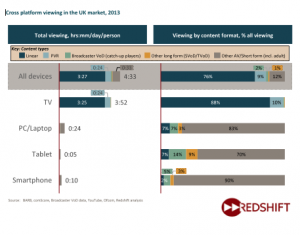
After more than 40 years of operation, DTVE is closing its doors and our website will no longer be updated daily. Thank you for all of your support.
Are we all going mobile?
 Adoption of mobile video is growing, but the live viewing experience remains key, argues Stephen Taylor of Redshift Strategy.
Adoption of mobile video is growing, but the live viewing experience remains key, argues Stephen Taylor of Redshift Strategy.
Are we all going mobile? Scarcely a week goes by without a news story reminding us how we have been seduced by the convenience and ease of use offered by mobile devices. Most recently it was YouTube, telling us that half of its views are now coming from mobile.
Redshift became interested in this issue working on a year-long project with BARB to help the UK’s ratings agency specify and tender for its next generation audience measurement service, Project Dovetail. Part of Dovetail’s goal is to deliver proper coverage of mobile devices. In the period until Dovetail goes live, there’s no single source to tell us just how big a part mobile plays in our overall viewing. We thought we’d try to fill the gap, and while we’re at it take a look at how mobile viewing may develop in future.
By combining a number of different sources, we came up with the picture of cross platform viewing – i.e. all video viewing, of all types of content, across all devices – in the exhibit below. It’s not perfect; measurement of PCs and mobile devices lags far behind TV. However, we’re confident the picture won’t change too much once BARB gives us a more reliable view.
This tells us we (everyone aged four and above) watch an impressive 4.5 hours of all forms of video on average every day. Just under four hours of this is on the TV, while 24 minutes is on the PC/laptop, 5 minutes is on tablets and 10 minutes on smartphones. These figures are averages across all viewers, whether or not they have access to each type of device.
This means mobile devices account for approximately 6% of overall viewing. These figures include an estimate for adult material – always poorly measured – but exclude DVD viewing and gaming.
We then looked ahead to try to understand how mobile viewing might be likely to change by 2020. There’s no question mobile viewing will increase – there are so many forces pushing in this direction: much improved mobile signal coverage via 4G and extended Wi-Fi; higher penetration for mobile devices, particularly tablets, which are likely to reach around 75% penetration by 2020; increasing use of mobile devices for video (it’s estimated around 50% of tablet owners use their devices for video today, and we have assumed this will increase to around 70% by 2020); and increasing ease of accessing long form and live linear content on mobile devices, which will significantly increase viewing on each active device – we assumed an increase of around a third.
On the basis of these assumptions, average tablet usage increases from five minutes per day to over 30 minutes per day by 2020, and smartphone usage increases to around 24 minutes/day; this means mobile devices would account for around 20% of total viewing, up from 6%.
These are very significant increases, and underline the ever-growing importance of mobile to distribution strategy.
However, while mobile is growing fast, it’s not going to take over the world; on the basis of this forecast, the TV would still account for 74% of total viewing. It’s hard to see the overall balance between TV and mobile shifting much further, because the quality of the viewing experience matters, and people are still likely to watch on the best screen available to them. The growing momentum behind 4K will only make the quality of the viewing experience more significant.
Younger viewers are often cited as the harbingers of fundamental shifts in viewing behaviour. If we look at the 16-34 age group, they are much more likely to be viewing on a mobile device. Their mobile viewing is twice as high as a percentage of the total – 12%. However, it’s still the case that linear channels comprises the majority of their viewing (around 60%). They watch significantly less on average, and they do watch a great deal more on demand content, but although they will remain entirely comfortable with the on demand experience and on demand brands like YouTube and
Netflix, they are still likely to turn to linear channels for a high proportion of their viewing. The pressure to view live will continue to be reinforced by social media and the increasing ease of instant messaging.
We took away a couple of other lessons from this exercise. The first was that there is a huge difference between platforms which provide access to linear channels and platforms which don’t; despite all the interest focused on platforms like Amazon’s Fire TV, Google’s Chromecast and Apple TV, these devices are secondary, complementary devices which provide no access to the majority of viewing which remains live and linear. To have a really significant role, new platforms have to include linear channels, and this comprises the single biggest obstacle to new entrants like Apple and Google.
However, the OS players will still be enormously influential in determining the future development of the viewing experience, as they will drive the established platforms to innovate and adapt the way programmes are presented in order to remain competitive. One way to look at Chromecast is to see it as part of Google’s drive to persuade us to use our mobile devices to control our TV viewing – a tablet really is an effective remote control. Perhaps it’s not mobile viewing, but viewing controlled by a mobile we should be focusing on.
Stephen Taylor is a Director of Redshift Strategy, an advisory firm focused on the media and telecoms sectors. He is speaking at the RTS Early Evening Event CONNECTED TV: DECODED on 26 November 2014. During this session they will explore the impact and implications of connected TV on the industry. To book your place visit the website.
